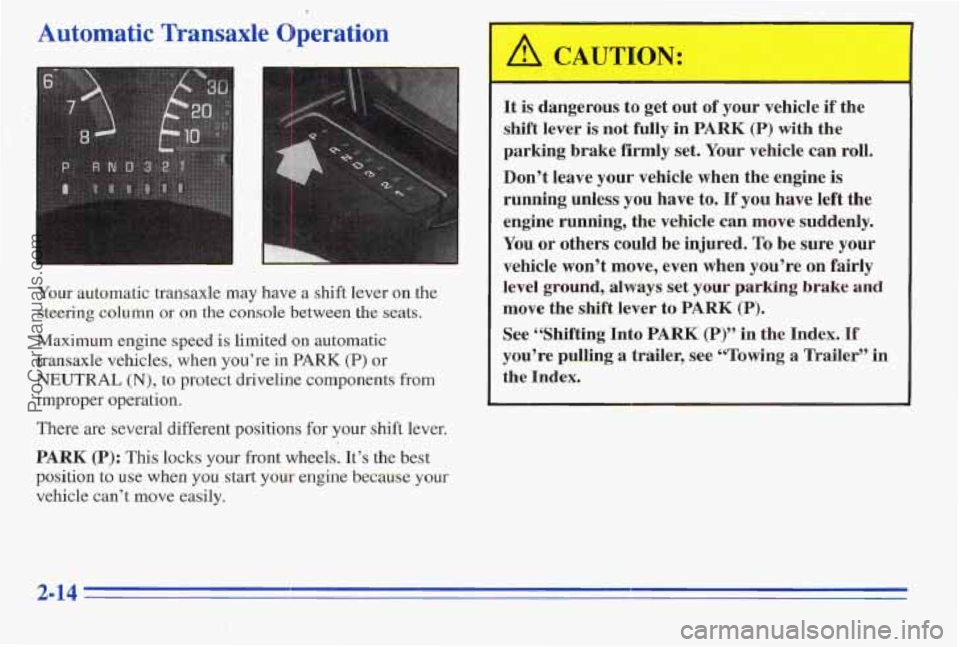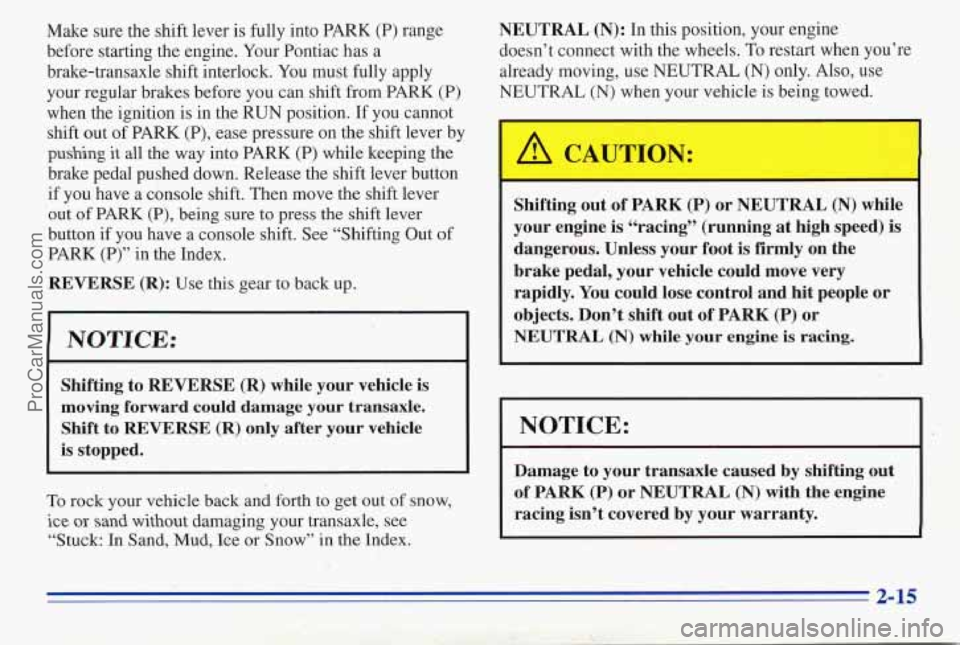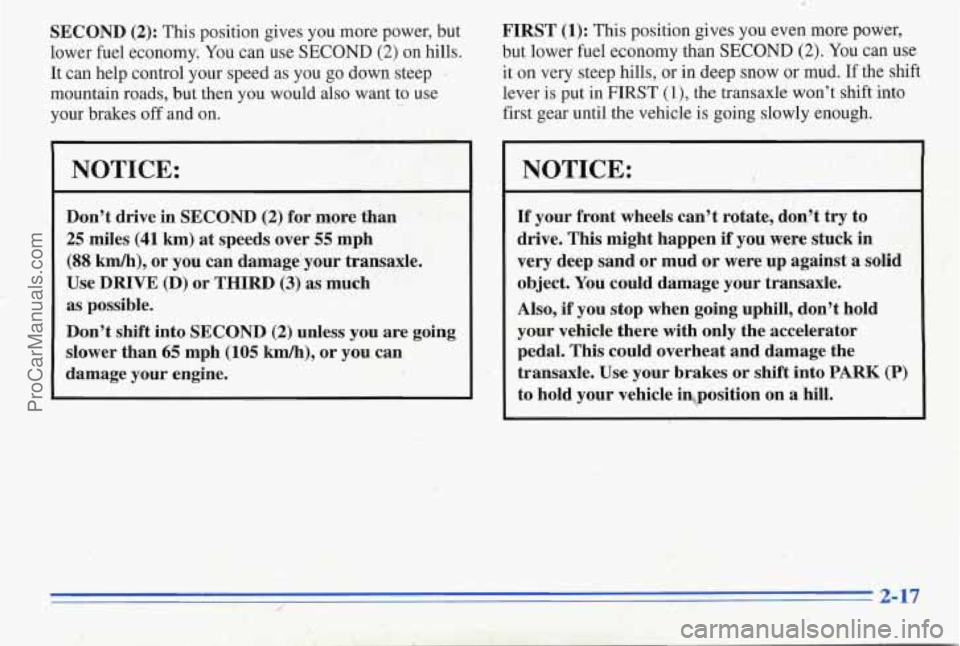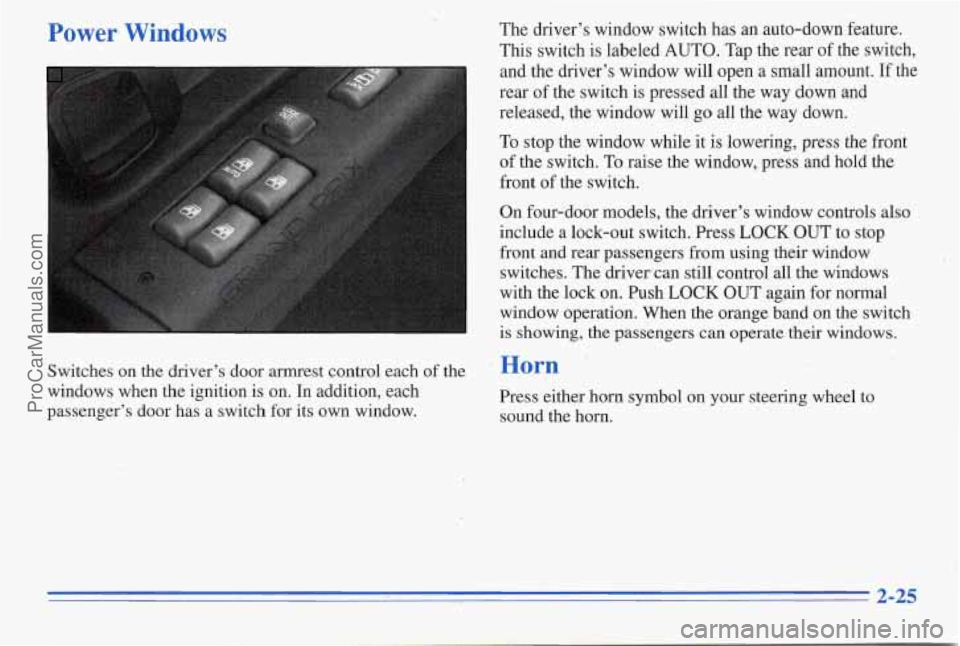Page 80 of 370

OFF (C): This position lets you turn off the engine but
still tuin the steering wheel. It doesn’t lock the steering
wheel like
LOCK. Use OFF if you must have your
vehcle pushed
or towed.
RUN (D): This position is where the key returns
after you start your vehicle. With the engine
off, you
can use
RUN to display some of your warning and
indicator lights.
: START (E): This position starts your engine.
A warning chime will sound
if you open the driver’s
door when the ignition is in the
OFF, LOCK or ACC
position and the key
is in the ignition.
NOTICE:
If your key seems stuck in LOCK and you can’t
turn it, be sure it
is all the way in. If it is, then
turn the steering wheel left and right while you
turn the key hard. But turn the key only with
your hand. Using
a tool to force it could break
the key or the ignition switch.
If none of this
works, then your vehicle needs service.
Starting Your Engine
Move your shift lever to PARK (P) or NEUTRAL (N).
Your engine won’t start in any other position -- that’s a
safety feature.
To restart when you’re already moving,
use
NEUTRAL (N) only.
NOTICE:
Don’t try to shift to PARK (P) if‘ your Pontiac
is moving.
If you do, you could damage the
transaxle. Shift to PARK
(P) only when your
vehicle is stopped.
1. Without pushing the accelerator pedal, turn your
ignition key
to START. When the engine starts, let
go of the key. The idle speed will go down as your
engine gets warm.
2-11
ProCarManuals.com
Page 83 of 370

Automatic Transaxle Operation
Yom automatic transaxle may have a shift lever on the
steering
column or on the console between the seats.
Maximum engine speed is limited
on automatic
transaxle vehicles, when you’re in
PARK (P) or
NEUTRAL (N), to protect driveline components from
improper operation.
There are several different positions for your shift lever.
PARK (P): This locks your front wheels. It’s the best
position to use when you start your engine because your
vehicle can’t move easily.
/I CAUTION:
It is dangerous to get out of your vehicle if the
shift lever is not
fully in PARK (P) with the
parking brake firmly set. Your vehicle can roll.
Don’t leave
your vehicle when the engine is
running unless you have to. If you have left the
engine
running, the vehicle can move suddenly.
You or others could
be injured. To be sure your
vehicle won’t move, even when you’re on fairly
level ground,
always set your parking brake and
move the shift lever to PARK (P).
See “Shifting Into PARK (P)” in the Index. If
you’re pulling a trailer, see LCTo~ing a Trailer” in
the Index.
ProCarManuals.com
Page 84 of 370

Make sure the shift lever is fully into PARK (P) range
before starting the engine. Your Pontiac has a
brake-transaxle shift interlock. You must fully apply
your regular brakes. before you can shift from PARK (P)
when the ignition is in the RUN position. If you cannot
shift out of PARK (P), ease pressure on the shift lever by
pushing it all the way into PARK (P) while keeping the
brake pedal pushed down. Release the shift lever button
if you have a console shift. Then move
the shift lever
out of PARK
(P), being sure to press the shift lever
button if you have a console shift. See “Shifting Out
of
PARK (P)” in the Index.
REVERSE (R): Use this gear to back up.
NOTICE:
.. .. ‘9: -. ~. - , . .. I. .,, :- . *.
Shifting to REVERSE (R) while your vehicle is
moving
forward could damage your transaxle.
Shift to REVERSE
(R) only after your vehicle
is stopped.
To rock your vehicle back and forth to get out of snow,
ice or sand without damaging your transaxle, see
“Stuck: In Sand,
Mud, Ice or Snow” in the Index.
NEUTRAL (N): In this position, your engine
doesn’t connect with the wheels. To restart when you’re
already moving, use NEUTRAL (N) only. Also, use
NEUTRAL (N) when your vehicle is being towed.
Shifting out of PARK (P) or NEUTRAL (N) while
your engine is “racing” (running
at high speed) is
dangerous. Unless your foot is firmly on the
brake pedal, your vehicle could move very
rapidly. You could lose control and hit people or
objects. Don’t shift out
of PARK (P) or
NEUTRAL (N) while your engine is racing.
NOTICE:
Damage,to your transaxle caused by shifting out
of PARK (P) or NEUTRAL (N) with the engine
racing isn’t covered by your warranty.
2-15
ProCarManuals.com
Page 86 of 370

SECOND (2): This position gives you more power, but
lower fuel economy; You can use SECOND
(2) on hills.
It can help control your speed as you
go down steep .
mountain roads, but then you would also want to use
your brakes off and on.
-
NOTICE:
Don’t drive in SECOND (2) for more than
25 miles (41 km) at speeds over 55 mph
(88 km/h), or you can damage’ your transaxle.
Use
DRIVE (D) or THIRD (3) as much
as possible.
Don’t shift into SECOND
(2) unless you are going
slower than
65 mph (105 km/h), or you can
damage
your engine. FIRST
(1): This
position gives you even more power,
but lower fuel economy than SECOND
(2). You can use
it on very steep hills, or in deep snow or mud.
If the shift
lever is put in
FIRST (l), the transaxle won’t shift into
first gear until the vehicle
is going slowly enough.
~
If your front wheels can’t rotate, don’t try to
drive. This might happen
if you were stuck in
very deep sand or mud or were up against a solid
object. You could damage your transaxle.
Also,
if you stop when going uphill, don’t hold
your vehicle there with only the accelerator
pedal. This could overheat and damage the
transaxle. Use your brakes or shift
into PARK (P)
to hold your vehicle iqposition on a hill.
ProCarManuals.com
Page 94 of 370

Power Windows The driver's window switch has an auto-down feature.
This switch is labeled AUTO. Tap the rear of the switch,
and the driver's window will open
a small amount. If the
rear of the switch is pressed all the way down and
released, the window will
go all the way down.
To stop the window while it is lowering,
press the front
of the switch.
To raise the window, press and hold the
front
of the switch.
.. . ._ 1 , ..1; 'T On four-door models, the driver's window controls also
7; include a lock-out switch. Press LOCK OUT to stop
. >. -. c with the lock on. Push LOCK OUT again for normal
. ., .I -. .. front and rear passengers from using their window . switches. The drivercan still control all the windows .- ..
. 5' .. .. window operation. When the orange band on the switch
is showing, the passengers can operate their windows.
Switches on
the driver's door armrest control each of the . Horn
windows when the ignition is on. In addition, each
Press either horn symbol on your steering wheel to
passenger's door has a switch for its own window.
sound the horn.
2-25
ProCarManuals.com
Page 95 of 370
Tilt Steer!-g Wheel
A tilt steering wheel allows
you to adjust the steering
wheel before
you drive.
You can also raise it to the
highest level to give
your
legs more room when you
exit and enter the vehicle.
To tilt the wheel, hold the steering wheel and pull the
lever. Move the steering wheel
to a comfortable level,
then release the lever to lock the wheel
in place.
Thrn SignaVMultifunction Lever
The lever an the left side of the steering column
includes
yoar:
m
a
0
2-26
ProCarManuals.com
Page 98 of 370
Cruise Control (Option)
With cruise control, you can maintain a speed of about
25 mph (40km/h) or more without keeping your foot on
the accelerator.
This can really help on long trips. Cniise
control does not work at
speeds below about 25 mph
(40 km/h).
When you apply your brakes, the cruise control- shuts off.
Cruise control can be dangerous where you
can’t drive safely at
a steady speed. So,
don’t use your cruise control on winding
roads or in heavy traffic.
slippery roads. 00 such road& f@t change& ’.
in tire traction can muse neediem wheel
spinning, and you
could lose conirol, Don’t
use cruise. eontrol on slippery roads.
Cruise controi can be dangerous on
2-29
ProCarManuals.com
Page 152 of 370
,Steering Wheel Controls (Option)
If your vehicle nas this feature, you can control certain
radio functions using the buttons on your steering wheel.
VOLUME: Press the up arrow to increase the volume
and the down arrow to decrease volume.
PLAY Press this button to play a cassette tape or
compact disc when the radio is playing.
MUTE: Press this button to silence the system. Press it
again, or any other radio button, to turn
on the sound.
SEEK: Press the up arrow to tune to the next radio
station and the down arrow to tune to the previous radio
station. If
a cassette tape or compact disc is playing, the
player will advance with the up arrow and rewind with
the down arrow.
PRESET Press this button to play a station you have
programmed on the radio preset buttons.
AM-FM: Press this button to choose AM, FM1 or FM2.
If a cassette tape or compact disc is playing, it will stop
and the radio will play.
3-21
ProCarManuals.com